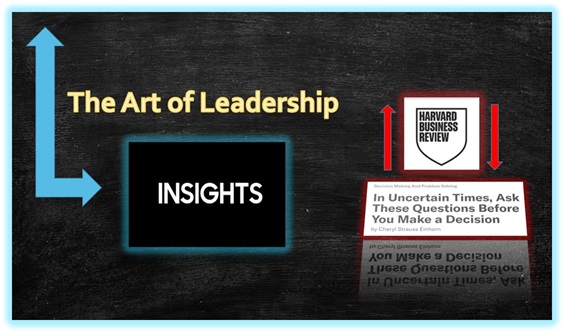
Resilient Leadership: Strategic Questions to Lead Through Uncertainty

In today’s world, uncertainty is not an occasional storm but a persistent climate. Leaders across sectors face a barrage of disruption, pandemics, cyberattacks, and supply chain breakdowns—that demand swift, resilient decision-making. The IBM Center for The Business of Government report, Preparing Governments for Future Shocks: A Roadmap to Resilience, illustrates the realities of leading through such volatility, highlighting the need for networked, agile, and innovative responses to complex challenges.
Recently, I read Cheryl Strauss Einhorn’s Harvard Business Review article, In Uncertain Times, Ask These Questions Before You Make a Decision, which offers a powerful framework of four strategic questions to navigate this “perma-crisis” landscape. These questions help leaders cut through noise, avoid reactive traps, and make choices that endure. By integrating Einhorn’s questions with the IBM report’s imperatives, government executives can enhance their ability to lead effectively through uncertainty, fostering resilient outcomes.
This essay explores how Einhorn’s questions can be used to navigate uncertainty, offering actionable insights for government leaders striving to thrive in uncertain times.
The Perma-Crisis Reality
The IBM Center report paints a vivid picture of today’s volatile environment, where “shocks”—disruptive regional or global events like wildfires, cyberattacks, or pandemics—transcend boundaries and stress governments, businesses, and communities. A 2023 IBM survey of 635 government executives found that 60% expect these shocks to grow more frequent, and 70% anticipate greater intensity. The report’s eight imperatives, from building governance networks to investing in agile innovation, underscore that siloed, reactive approaches are inadequate. Instead, leaders must foster collaboration across sectors, leverage data and AI, and prioritize public trust to build resilience.
Einhorn’s article complements this by addressing the decision-making paralysis that volatility can induce. Traditional questions—What’s the ROI? What’s the timeline?—often narrow focus too soon, locking leaders into outdated assumptions. Her four questions, designed to expand perspective and spark creativity, are particularly relevant for navigating the systemic disruptions the IBM Center report describes.
Below, each question is explored as a tool for leaders, with examples drawn from the report to illustrate their practical impact in a crisis-prone world.
Question 1: What Decision Today Will Still Make Sense a Year from Now?
Einhorn’s first question urges leaders to prioritize decisions with lasting value, resisting the pull of short-term fixes. In a crisis, the pressure to act quickly can lead to choices that solve immediate problems but create future vulnerabilities. This question injects long-term thinking into chaotic moments, ensuring alignment with core values and strategic goals. The IBM Center report illustrates this challenge in its discussion of supply chain disruptions, a common shock that tests resilience. For instance, a government agency facing delayed medical supply deliveries might be tempted to double down on a struggling vendor for quick relief.
Einhorn’s question prompts a broader view: Will this decision hold up in a year? Preparing Governments for Future Shocks: A Roadmap to Resilience emphasis on building a Center of Excellence (CoE) for supply chain resilience offers a solution. By creating a multi-agency hub with private sector and academic partners, leaders can map supply chains using AI-driven analytics, ensuring robust sourcing strategies that withstand future disruptions. This mirrors Einhorn’s example of Alana, a consumer brand leader who preserved sustainability initiatives despite cost-cutting pressures, balancing immediate needs with long-term brand identity.
Practical Takeaway: Leaders should use scenario planning to test decisions against potential future shocks, such as disasters or cyberattacks. By asking, “What values do we want this decision to reflect?” they can align choices with resilience goals, as the Center report advocates through its call for proactive risk management.
Question 2: If a Year from Now This Decision Was Used as an Example of Our Leadership, What Would It Teach?
This question shifts focus to the narrative a decision creates, asking leaders to consider the legacy their choices leave. It’s not just about outcomes but about what decisions say about character, priorities, and culture.
In a world where trust in institutions is eroding, as the Center report notes via the Edelman Trust Barometer’s findings, this question is a strategic tool for building credibility.
Preparing Governments for Future Shocks: A Roadmap to Resilience highlights the importance of public participation and communication to counter distrust, especially during climate disasters. Consider a city official deciding whether to enforce a mandatory evacuation in a flood-prone, low-income area. The legal case is clear, but community fears of displacement loom large. Einhorn’s question—What would this decision teach about our leadership?—prompts a human-centered approach. The Center report suggests engaging trusted community voices to communicate risks, avoiding “maladaptation” where poorly planned responses increase vulnerabilities. By involving local leaders to co-design an evacuation plan that addresses financial and medical barriers, the official not only mitigates the crisis but also models inclusive leadership, much like Einhorn’s example of Raj, who delayed a product launch to prioritize ethical data practices, earning trust and respect.
Practical Takeaway: Leaders should integrate stakeholder input into decisions, using town halls or digital platforms to ensure diverse voices shape outcomes. This builds trust and reinforces a leadership legacy of integrity, aligning with the Center’s report call for inclusive planning.
Question 3: What If This Isn’t the Storm—What If It’s the Climate?
Einhorn’s third question challenges the instinct to treat disruptions as temporary, urging leaders to prepare for persistent volatility. This reframing is critical in a world where shocks are not anomalies but part of the systemic “climate,” as the Center’s report survey data confirms with expectations of escalating crises.
The IBM Center report, Preparing Governments for Future Shocks: A Roadmap to Resilience, focuses on crosscutting shocks, like recurring cyberattacks, illustrates this reality. A government IT department facing repeated data breaches might initially patch systems reactively, hoping for a return to stability. Einhorn’s question—What if this is the new normal?—prompts a strategic shift. Our report advocates for a whole-of-government approach, including cross-agency collaboration and AI-enhanced cybersecurity frameworks. By investing in a CoE that coordinates federal, state, and private sector efforts, leaders can build systems that flex under pressure, not snap. This echoes Einhorn’s example of Darryl, who recognized a vendor’s persistent failures as a structural issue, launching a dual-track plan to onboard a new supplier while giving the existing one a final chance to improve.
Practical Takeaway: Leaders should conduct regular wargaming exercises to anticipate ongoing shocks, as the Center report suggests. By mapping interdependencies across sectors, they can design enduring systems, ensuring resilience against chronic uncertainty.
Question 4: What’s the Cost of Waiting?
Einhorn’s final question confronts the hidden risks of inaction, challenging leaders to act despite incomplete data. In volatile environments, waiting for certainty can forfeit momentum, market position, or public confidence.
Consider a public health agency debating whether to adopt AI for predicting disease outbreaks. Budget constraints and ethical concerns might encourage delays. Einhorn’s question—What’s the cost of waiting?—highlights the risks: slower responses, strained resources, and eroded trust. The Center report cites generative AI’s potential to optimize emergency responses by analyzing vast datasets, enabling faster resource allocation. By piloting an AI system with built-in safeguards, the agency could act decisively, mirroring Einhorn’s example of Monica, who hired a marketing officer during economic uncertainty, reimagining compensation to align with strategic goals.
Practical Takeaway: Leaders should launch agile pilot programs to test innovations. Pre-crisis data strategies, like those recommended for data-driven decision-making, ensure informed action, minimizing the costs of hesitation.
A Unified Approach to Resilient Leadership.
Einhorn’s four questions form a cohesive framework for leading through uncertainty, each addressing a critical dimension of decision-making:
-
Durability ensures decisions withstand future shocks, aligning with the IBM Center report’s call for proactive risk management.
-
Legacy builds trust through inclusive choices, supporting the Center report’s emphasis on public engagement.
-
Systemic Thinking prepares for persistent volatility, echoing the report’s call for crosscutting strategies.
-
Urgency drives timely action, complementing the report’s push for agile innovation.
The Center's report focus on workforce development further ties these questions together, as a skilled, adaptable workforce is essential for executing resilient decisions. With government leaders planning to shift investments toward AI in five years, upskilling employees to leverage technology is critical, ensuring the human capital to act on Einhorn’s insights.
Implementing Einhorn’s Framework
To apply Einhorn’s questions in practice, leaders can take these steps:
-
Embed Questions in Planning: Train teams to use Einhorn’s questions during strategic discussions, ensuring decisions balance short- and long-term goals.
-
Leverage Technology: Use AI and data analytics to model decision outcomes, as the IBM report suggests, supporting Questions 1 and 3.
-
Engage Communities: Host inclusive forums to gather input, aligning with Question 2’s focus on leadership legacy.
-
Pilot Innovations: Test solutions rapidly to address Question 4, minimizing inaction costs.
-
Upskill Teams: Invest in training to ensure employees can implement data-driven, resilient decisions.
Conclusion: Turning Uncertainty into Opportunity
Government executives navigating future shocks cannot rely on outdated assumptions or siloed responses. The IBM Center report, Preparing Governments for Future Shocks: A Roadmap to Resilience depicts escalating shocks that underscore the need for adaptive, collaborative leadership. The report’s eight imperatives provide a roadmap for resilience, emphasizing networked governance, agile innovation, and inclusive communication. Einhorn’s four questions, outlined in her HBR article, complement this by offering a decision-making lens that balances urgency with foresight, reactivity with strategy, and isolation with collaboration.
By asking what decisions will endure, what legacy they create, whether disruptions are systemic, and what inaction costs, leaders can transform uncertainty into opportunity.
As Einhorn reminds us, strategic decision-making isn’t about having all the answers: it’s about asking the right questions to forge a resilient future. In a perma-crisis world, strategic questioning is not just a tool—it’s a leadership imperative.



